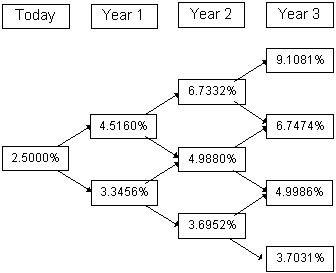- CFA Exams
- 2026 Level II
- Topic 6. Fixed Income
- Learning Module 27. The Arbitrage-Free Valuation Framework
- Subject 2. The Basics of Creating a Binomial Interest Rate Tree
Why should I choose AnalystNotes?
Simply put: AnalystNotes offers the best value and the best product available to help you pass your exams.
Subject 2. The Basics of Creating a Binomial Interest Rate Tree PDF Download
In this section we will value a bond using a binomial interest rate tree.
i1,H = i1,Le2 σ
where
The Binomial Interest Rate Tree
As its name suggests, the binomial interest rate tree models future periods with two distinct scenarios: an "up" scenario and a "down" scenario. The tree "grows" by repeating this assumption at every point in time. This binomial process continues until maturity.

The interest rates in a tree are implied forward rates. They are based on three assumptions:
- An interest rate model that governs the random process of interest rates.
- The assumed level of interest rate volatility.
- The current benchmark yield curve.
Interest rates can take on negative values with positive volatility. We can fix the problem by working with logs. Lognormal distribution of interest rates has two appealing properties:
- Interest rates can never become negative.
- The absolute change in interest rates becomes smaller and smaller once they get too close to zero.
Recombining trees means that an upward-downward sequence leads to the same result as a downward-upward sequence. That is, rul = rlu. At period n there are n + 1 different values.
The relationship between the two adjacent rates:
- σ is the assumed volatility of the one-period rate.
- e is the base of natural logarithms.
- i1,H is the higher of one-period forward rate one period from now.
- i1,H is the lower of one-period forward rate one period from now.
The Role of Volatility
For a lognormal distribution the standard deviation of the one-year rate is equal to i0 σ.
There are two ways to estimate the volatility:
- The historical estimate is based on what happened in the past.
- Use a model (e.g., Black-Scholes-Merton model) and its other inputs (strike price, call option price, time to expiration, etc.) to estimate the standard deviation.
User Contributed Comments 3
| User | Comment |
|---|---|
| myron | It's more for callable bonds, or bonds with some sort of embedded option. You need to see the possibilities in the next period (nodes of the tree) in order to determine the optimal action today. |
| connor15 | The volatility of the interest rate is based on the difference between an up movement and a down movement. Higher volatility requires a bigger difference between up and down movements. |
| connor15 | Recombining trees means that an upward-downward sequence leads to the same result as a downward-upward sequence. That is, Rul = Rlu. At period n there are n+1 different values. |

I was very pleased with your notes and question bank. I especially like the mock exams because it helped to pull everything together.

Martin Rockenfeldt
My Own Flashcard
No flashcard found. Add a private flashcard for the subject.
Add